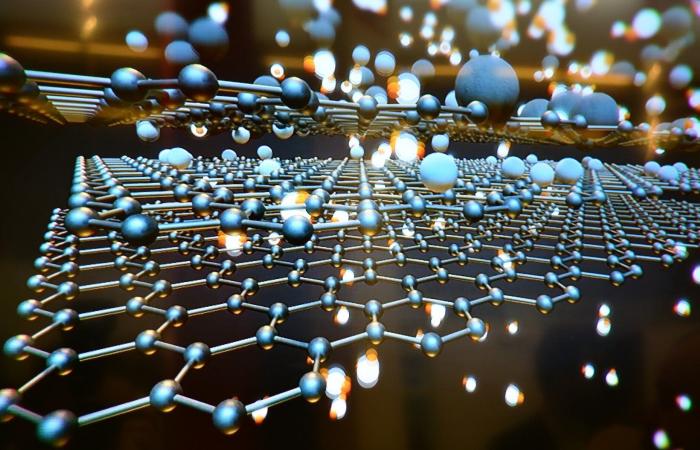At the University of Alabama in Huntsville (UAH), part of the University of Alabama system, a new method was invented to deposit thin layers of atoms as a coating on a substrate material at near room temperature.
UAH postdoc Dr. Moonhyung Jang, came up with the idea of using ultrasonic atomization technology to vaporize chemicals that are used in atomic layer deposition (ALD) when buying a home humidifier.
Dr. Jang works in Dr. Yu Lei, an associate professor in the Department of Chemical Engineering. The couple have published a paper about their invention that is listed as the editor’s choice in the Journal of Vacuum Science & Technology A..
“ALD is a three-dimensional thin-film deposition technique that plays an important role in the manufacture of microelectronics, in the manufacture of elements such as central processing units, memories and hard drives,” says Dr. Lei.
Each ALD cycle deposits a layer a few atoms deep. An ALD process repeats the deposition cycle hundreds or thousands of times. The uniformity of the thin films is based on a self-limiting surface reaction between the chemical precursor vapor and the substrates.
“ALD provides exceptional control of nanometer features while depositing materials on large silicon wafers for mass production,” said Dr. Lei. “It is a key technology to create powerful and small intelligent devices.”
While Dr. Looking online for a safe and easy-to-use humidifier for the home, Jang found that humidifiers on the market either use direct heating at high temperatures or vibration of the ultrasonic nebulizer at room temperature to create the water mist.
“Moon suddenly realized that the latter could be a safe and easy way to create fumes for reactive chemicals that are thermally unstable,” says Dr. Lei.
“The next day, Moon came to discuss the idea, and we designed the experiments to prove the concept in our research lab. The whole process took almost a year. But the great idea came to Moon like lightning. ”
ALD processes typically rely on heated gas phase molecules that are vaporized from their solid or liquid form, similar to room humidifiers that use heat to vaporize water. In this ALD process, however, some chemical precursors are not stable and can decompose before a sufficient vapor pressure for ALD is achieved.
“In the past, many reactive chemicals were considered unsuitable for ALD because of their low vapor pressure and thermal instability,” says Dr. Lei. “Our research showed that ultrasonic atomization technology allowed the reactive chemicals to evaporate at only room temperature.”
The UAH scientists’ ultrasound invention enables the use of a wide variety of reactive chemicals that are thermally unstable and not suitable for direct heating.
“The ultrasonic atomization developed by our research group provides precursors with low vapor pressure, since the precursors were vaporized by ultrasonic vibration of the module,” says Dr. Lei.
“As with household humidifiers, ultrasonic atomization creates a mist made up of saturated vapors and micro-sized droplets,” he says. “The micro-sized droplets vaporize continuously when the mist is released onto the substrates by a carrier gas.”
The method uses an ultrasonic piezoelectric transducer placed in a liquid chemical precursor. After starting, the transducer begins to vibrate a few hundred thousand times per second, creating a mist of the chemical precursor. The small liquid droplets in the mist are quickly evaporated in the gas distributor under vacuum and mild heat treatment, leaving an even layer of the deposition material.
“With the ultrasonic atomization at room temperature described in our manuscript, new ALD methods using low volatility and unstable precursors could be developed,” says Dr. Lei. “It will open a new window for many ALD processes.”
In their work, the UAH researchers demonstrate the proof of concept by comparing titanium oxide ALD with thermally vaporized or ultrasonically atomized chemical precursors at room temperature.
„Das TiO2 The thin film quality is comparable “, says Dr. Lei.
New chemistry for ultra-thin gas sensors
More information:
Henrik H. Sønsteby et al. tert-butoxides as precursors for the atomic layer deposition of alkali metals, which contain thin films, Journal of Vacuum Science & Technology A. (2020). DOI: 10.1116 / 6.0000589
Provided by the University of Alabama at Huntsville
Quote: Researchers develop a new process for the deposition of atomic layers (2020, October 27), which was accessed on October 27, 2020 from https://phys.org/news/2020-10-atomic-layer-deposition.html
This document is subject to copyright. Except for fair trade for the purpose of private study or research, no part may be reproduced without written permission. The content is provided for informational purposes only.
These were the details of the news The researchers are developing a new atomic layer deposition process for this day. We hope that we have succeeded by giving you the full details and information. To follow all our news, you can subscribe to the alerts system or to one of our different systems to provide you with all that is new.
It is also worth noting that the original news has been published and is available at de24.news and the editorial team at AlKhaleej Today has confirmed it and it has been modified, and it may have been completely transferred or quoted from it and you can read and follow this news from its main source.

